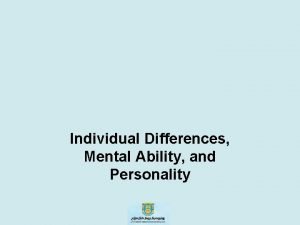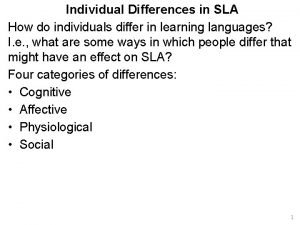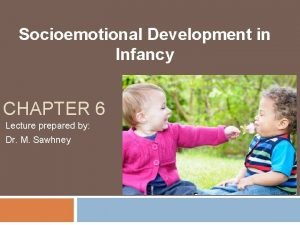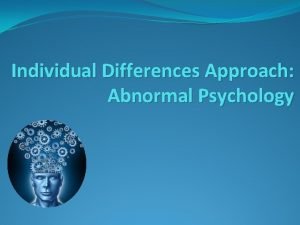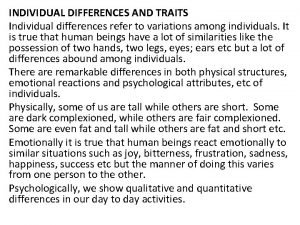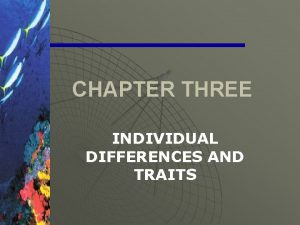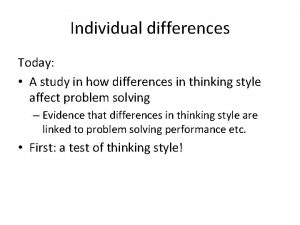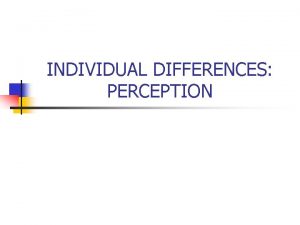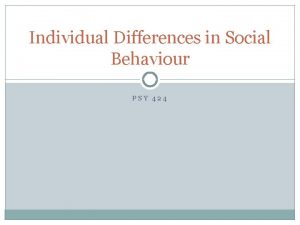The Individual Differences Area The individual differences area















- Slides: 15


The Individual Differences Area The individual differences area looks at differences between people, whereas previous approaches have tended to look at factors that are common to all people. This means we will be looking at differences between people, rather than what people have in common. This area covers intelligence and personality and the way that these have been tested, concepts and definitions of normality and abnormality, and a huge range of descriptions and explanations of a variety of mental health disorders.

Key assumptions: • Behaviour can be explained by focusing on the differences between individuals • Researchers should focus on dispositional explanations of human behaviour, where behaviour is caused by you as an individual, rather than the situation you are in • Assumes behaviour can be largely explained in terms of personality traits, intelligence, normality, ways of thinking and emotional responses. • Every individual is unique

Unique Personality Measuring differences Ideographic Characteristics Psychological attitudes Complex behaviour Case studies KEY TERMS

Freud (1909) ‘Little Hans’ Area: Individual differences area Theme: Understanding differences

Freud Psychodynamic perspective • Three parts of the mind • Three parts of the personality • Defense mechanisms to reduce anxiety caused due to personality • Psychosexual stages of development

Background: • Little Hans was a five-year old boy with a phobia of horses. Freud did not use this case study to treat the child’s phobia. Instead, he wanted to explore what factors may have led to the phobia in the first place. • By 1909, when the study took place, Freud’s ideas about the Oedipus complex were well-established. It is important to note that Freud did not work directly with Little Hans. Instead, he worked through correspondence with Hans’ father was familiar with Freud’s theories and, it can be argued, was a big fan of his.

Aim: Freud wanted to see if his beliefs on the following could be supported: • Parts of the mind • Importance of dreams • Psychosexual stages of development • Most importantly, the Oedipus complex

Method: Case study • Detailed study of one individual = Little Hans Longitudinal • Study was carried out over a long period of time (2 years) • From when Hans was three years old until he was five Qualitative data • Data gathered from Little Hans’ father through observations and conversations with him. This information was then sent to Freud.

• The data collected from Little Hans’ father was as follows: • At the age of three, Hans developed an interest in his ‘widdler’ (penis) and he started to masturbate. • This caused his mother distress and she threatened she would have a doctor cut his penis off. This caused Hans distress. • At three and a half years old, Little Hans’ sister was born. He resented her and hoped she would drown in a bath.

• After a short time afterwards, Hans developed a fear for white horses and being bitten of them. This seemed to relate to two key incidents: • He overheard a man say “Don’t put your finger to the white horse or it will bite you” • He saw a horse pulling a carriage fall down. • As a result, his phobia generalised to horses and carts. • It was also reported that before and after the development of the phobia, Hans was anxious that his mother would leave. He experienced fantasies including one about a giraffe and two plumber fantasies. (These will be analysed)

Results: • The above information about Little Hans was analysed by Freud came up with the following findings: Hans’ ‘widdler’ • Hans’ obsession with his ‘widdler’ was a sign of Hans being in the phallic stage. This supports Freud’s psychosexual stages of development.

Horses • Hans developed a phobia of horses. Freud analysed this and thought horses were suitable father-figures because of their large penises. And so, Freud identified Hans’ was unconsciously afraid of his father. Evidence to support this comes from Hans’ particular fear of horses with darkness around their mouth (which Freud thought represented his fathers beared) and blinkers (which represented his fathers glasses). This suggesting Hans was experiencing the Oedipus complex (desire for mother, and want to get rid of his father). •

Giraffes • As identified above, Hans witnesses a horse collapse. This introduced him to the idea that things can die. Little Hans’ reportedly said ‘In the night there was a big giraffe in the room and a crumpled one: and the big one called out because I took the crumpled one away from it. Then it stopped calling out: and I sat down on top of the crumpled one’. Freud analyzed this as Hans’ father being the big giraffe and his mother being the crumpled one. According to Freud, Hans’ has a desire to take his mother away from his father. This supporting Freud’s beliefs of the Oedipus complex further.

Conclusions: • Little Hans’ study provides support for Freud’s theory of psychosexual development, specifically that boys in the phallic stage experience the Oedipus complex • Phobias are caused by unconscious anxiety being displaced onto harmless external objects • Hans is an example of unconscious determinism, which suggests that people are not consciously aware of their behavior. • Freud claims psychoanalysis was an effective treatment for Little Hans because it identified the unconscious cause of the abnormality which was then brought into the conscious to be discussed and resolved.
 What is growth and development
What is growth and development What are type a people
What are type a people Principles of training individual differences
Principles of training individual differences Individual differences factors
Individual differences factors Individual differences in sla
Individual differences in sla Managing individual differences and behavior
Managing individual differences and behavior Thomas and chess temperament
Thomas and chess temperament Makalah perbedaan individu dalam organisasi
Makalah perbedaan individu dalam organisasi Unit xi testing and individual differences
Unit xi testing and individual differences Managing individual differences and behavior
Managing individual differences and behavior Conclusion of individual differences
Conclusion of individual differences Apa makna perbedaan individu dalam dunia kerja
Apa makna perbedaan individu dalam dunia kerja 5 principles of training
5 principles of training Individual differences factors
Individual differences factors điện thế nghỉ
điện thế nghỉ Dot
Dot

